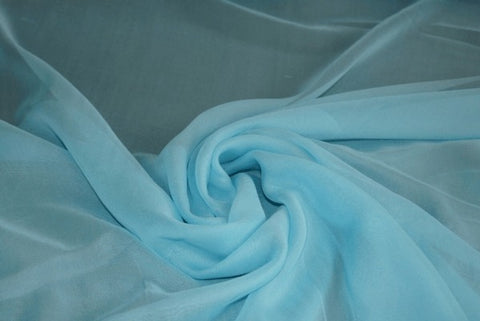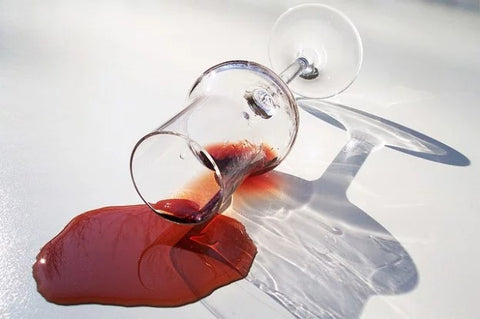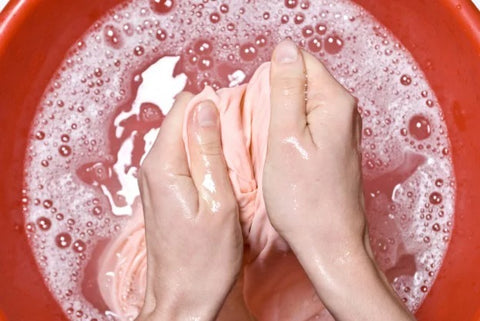How to clean your tulle wedding Dress
by Karen
Finding the perfect tulle wedding dress can be the accomplishment of a lifetime. Whether you discovered the dress in a chic second-hand boutique, or had yours handcrafted, it's a garment that you'll want to keep in perfect condition for a lifetime. Sometimes though, life intervenes, and you'll find that food or drink has left an indelible spot on your beautiful dress.
Instead of panicking, simply follow the guide below for removing your unwanted tulle wedding dress stain. Tulle is a delicate fabric, but the good news is that almost any kind of spot can be easily removed, restoring your dress to perfect condition once again. The most important thing is to be patient, as a quality cleanser should be able to loosen up even the most persistent of stains.
Step 1 - Test Washing
Regardless of what kind of food or drink has stained your dress, it's important that you test out your cleaning product. It's important to see how the cleanser is going to affect the fabric, so pick a small hidden section of the tulle and test it there first.

Step 2 - Cleaning Basics for Tulle
In general, try using COLD water and a very mild soap when cleaning your tulle. An organic soap made from all-natural ingredients is always the best cleanser to start with. Most of the time, you'll want to wash out the spot by hand.
Note: strong detergents and bleach should NEVER be applied to tulle. These can discolor or even destroy the delicate fabric.
Most washing machines are far too rough to handle the delicate tulle fabric. Some modern machines, however, have an extremely gentle setting for washing. If your machine can handle sensitive fabrics, use only cold water and a very mild soap.
Never ever use a dryer for your tulle dress. The heat from the machine will not just dry out your dress, but cause the fabric to become rough and brittle. Once your tulle dress is clean, you can let it air dry, as this will not cause any damage.
Follow the guide below to remove a select number of unwanted tulle wedding dress stains:
Removing Grease Stains
Grease stains are one of the most common imperfections the befall worn and vintage clothing. They can be caused by anything from spilled food to cosmetics to an accidental brush against a car door. How you treat a grease stain on a tulle gown will depend on how long the spot has been there. If, for example, you purchase or inherit a vintage tulle gown that already has a stain, you will treat the spot differently than you would treat a gown with a stain that happened minutes ago.

First, and most importantly, don’t put your dress in the washing machine! Tulle rips and tears easily, and even the delicate cycle on most washing machines could cause the fabric to snag. Always hand wash your vintage gown.
To treat an old stain, the first step in removing an old grease stain from a tulle gown is to fill a bathtub with hot water and add OxiClean according to the package directions. You can also create a paste with a little warm water and OxiClean and gently rub it into the spot with your fingers to pre-treat it before soaking. OxiClean is a good choice because it is a gentle yet strong cleaner that is ideal for protein-based stains such as those that happen with food. It also doesn’t contain chlorine, which can be harmful to older fabrics or delicate knits like tulle. Speaking of chlorine, you definitely do not want to use any type of bleach on tulle. Not only will it damage the fabric, but it will likely cause the stained area to be a much lighter color or shade from the rest of the dress. As an alternative, you can pre-treat spots with a small amount of dishwashing liquid applied gently to the back of the affected area.
Once you’ve pre-treated any spots, place the dress in the tub of hot water to soak for several hours. It may take more than one soak, so monitor the color of the water carefully to verify that the stain is coming out and continue refreshing the water to keep it clean and very warm. Note that this process may also change the color of your vintage garment from cream or off-white to its original cleaner, crisper white. Again, this depends on how the garment has been worn and stored. One advantage of removing stains by soaking and cleaning the entire garment is that you won’t end up with one or more spots that are a different color because they are actually cleaner than the rest of the gown!
What if the grease stain you are dealing with just happened? What if you spilled a piece of that delightful buttery shrimp on your vintage tulle gown at your reception? First, don’t panic! The most important thing you can do is treat the stain quickly. Your first instinct might be to grab the nearest washcloth or paper towel and rub out the stain, which is the worst thing you can do! Rubbing any type of stain will only set it deeper into the fabric and make it much more difficult to remove. Also, colored fibers or dye from towels that are not white can adhere to the stained area and discolor the dress even more.
Although tulle is transparent, you will want to turn the fabric layer inside out to treat it. First, use a clean white towel to blot away any of the excess material. Use a small amount of dishwashing liquid and gently rub it into the stain, taking care not to stretch or alter the shape of the garment. Rinse the area thoroughly with very warm water. If you have club soda available, it is another reliable stain-removal option. Place paper towels underneath the stained area, again making sure you are treating the stain from the back of the fabric, and gently massage the club soda into the spot with your fingertips. Be careful not to stretch or tear the tulle during this process. Rinse gently with warm water until the stain is gone.
Removing Red Wine Spots

Red wine can be one of the most difficult stains to remove from any fabric. With a fragile fabric like tulle, red wine spots can be a difficult challenge. But the faster you treat the stain, the more likely you are to successfully remove it from your dress.
After testing your cleanser, try applying some cool water and a tiny bit of mild soap to the affected area. Rub it very, very gently between your hands and see if the spot has started to disappear. If this solution is working, continue until all traces of the red wine are gone. Then thoroughly rinse out all of the soap and hang up the dress to air dry.
If the red wine spot remains persistent, put the area directly under the faucet and turn on the cold water. Add a drop or two of mild detergent to the area and then gently rub the fabric, being careful not to tear or damage the netting. If this process works, then continue until the red wine spot is completely eradicated. Then make sure to rinse out the tulle under the faucet until all of the soap has been washed out. Hang up the dress to drip dry.
Because red wine contains unique staining ingredients, it can be difficult to remove red wine spots with a quick hand cleaning. In urgent cases, fill a bathtub or large basin with cold water, enough to immerse the stained area of your dress. Apply a little mild soap or laundry detergent, and briskly stir the water until a few light suds form. Allow the stained portion of the dress to soak for at least an hour, or as long as overnight. Given time, the soapy water will work to gently loosen even the most persistent of red wine spots. Dump out the water and continue to flush the dress with fresh cold water until all traces of the soap are completely gone. Hang outside on a clothesline and allow to air dry.
Removing Chocolate Stains
Whether it is the icing on the cake or flowing from a cascading fondue fountain, chocolate is a staple of many special occasions. What should you do if your flower girl accidentally runs into you while carrying a chocolate-covered strawberry and it gets all over your vintage tulle wedding gown? The first and more important step is to treat the chocolate stain quickly. Place a layer of plain white paper towels under the spot to protect the fabric underneath it. If it is a solid stain, gently use a spoon or butter knife to remove as much excess chocolate as possible. Be careful not to damage the tulle, and don’t try to remove the chocolate if it is dried or caked-on the fabric. If it is melted or in liquid form, use a clean white towel to blot away as much of the chocolate as possible without smearing it further.
Unlike with grease spots or red wine stains, you will need to use cold water to remove chocolate stains. If you use hot water, it will react with the proteins in the chocolate to set in the stain, making it more permanent and harder to remove. Turn the garment or layers of tulle inside out and gently rinse the stained area of the dress with cold water to remove as much of the chocolate as possible. Then, use a gentle detergent or dishwashing liquid and rub it carefully into the stain. Rinse with cold water and repeat multiple times until the chocolate stain is gone. As with other types of stains, it is important to air-dry the garment and not apply heat until the stain is removed completely.
If the chocolate spot has hardened and refuses to be rubbed out with the hand washing methods described above, fill a clean bathtub or large basin with cold water. Add a drop or two of a mild detergent to the water, and stir enthusiastically until suds start to form on the surface. Allow the dress to soak for 30 minutes to two hours, giving the ionic action of the detergent to loosen the chocolate's grip on your tulle. After the soaking period, gently rub the fabric to loosen any remaining areas of chocolate stain. Once your dress is clean, drain the water and repeatedly rinse the dress with cold water until absolutely all of the soap is gone. Then hang your dress to drip dry.
Removing Grass Stains
In the pantheon of stains, almost none are feared more than grass stains. However it is that grass is the culprit of your tulle wedding dress stain, the good news is that it is usually possible to clean it.

If your attempts to hand wash the stain out aren't entirely effective, place the grass stained area of the tulle directly under a faucet running cold water. Place a few drops of your pre-tested cleanser on the affected area. Frisk between your palms until soap suds start to appear. You should see the grass spot lightening within a few seconds. Continue rubbing until all of the stain has been removed. Then thoroughly flush the wetted area with water until all of the soap has been flushed out.
For more extreme cases, you'll have to soak your tulle dress to get rid of the grass stain. Place your dress in a bathtub or big basin filled with cold water until the dress is completely immersed. Add just enough soap to create suds when you briskly stir the water. Allow the dress to rest for at least 30 minutes, and as possibly long as overnight. This should completely loosen the grass stain from the tulle material, but you may have to gently rub to remove the last few offending spots. Once the dress is clean, drain the water and then thoroughly wash the tulle until all of the detergent has been removed. Hang on a clothesline and allow to air dry.
Removing Blood Spots
Due to the iron and the proteins in blood, few stains are as hard to remove as blood. As with any other kind of soiling, be sure to wash your tulle dress as soon as possible for best results.
After pre-testing your detergent, soak the offending area with cold water and apply a drop or two of your cleanser. Using caution not to tear or damage the netting, gently rub the wetted area between your hands to loosen up the stain. If you see this process is working, continue until all of the blood has been removed. Then thoroughly rinse out the tulle until all of the soap or detergent has been washed out. Hang up the dress to air dry.
For particularly pernicious blood stains, only time and the ionic action of a quality cleanser will be able to loosen the stain without damaging the fragile tulle. Fill a clean bathtub, large basin, or other receptacle with cold water. Add a few drops or sprinkles of a mild cleanser to the water. Using your hands, briskly froth the water until you see a few soap suds start to form. Allow the dress to soak for a minimum of one hour, or possibly as long as overnight, in order to allow the soap to do its work. When you check on your dress, you should see that the stain has become loosened. Rub the fabric gently between your hands and finish removing any remaining stubborn spots. Then drain the water and thoroughly flush the dress with cold water until all traces of the soap have been removed. Hang the dress on a clothesline and allow to drip dry.
Wrinkle Removal
Whether as a result of wearing the dress or being air dried, it is possible for your tulle to become wrinkled. Luckily, it is fairly simple to restore your dress to perfect condition and smooth out the wrinkles.
You can use a normal clothes iron to press out the wrinkles, but it is essential to never let the hot iron make direct contact with the material. The heat from the iron can melt or cause the tulle to become brittle. Place a cloth over the wrinkled part of the tulle, and then iron the spot as you would normally. The cloth will shield your tulle from the damaging heat while still transferring enough power to the fabric to smooth out the wrinkles.
Another great option is Steaming the garment, especially once it is dry. To do so, hang the dry gown on a padded fabric hanger and make sure that the steamer is several inches away from the delicate fabric. Steam can also aid in the removal of grease spots.
How to Dry a Tulle Gown after Stain Removal
It is never advisable to place a tulle garment in the dryer, and you definitely don’t want to dry or iron a garment that is still stained. The drying process will set the stain in more permanently. The best way to dry a tulle garment once you’ve removed any spots is to use rolled-up towels or pins and lay the garment flat to maintain its original shape and design. If you don’t lay it out carefully, the tulle can lose its structure, its hemlines can stretch and become uneven, and the overall silhouette of the gown can get distorted. You also want to avoid hanging the wet garment on a hanger, as the weight of the water might cause the dress to stretch or damage the sleeves and shoulders.
A technique called blocking will help ensure that your newly cleaned gown maintains its original shape. To block the garment, first lay down a layer of clean white towels on a flat, dry surface. Then, gently lay out the garment on top of the towels. Use rolled up towels in the sleeves and the bodice to maintain their shape. Be very mindful of the hemline of your vintage gown. Lay it out evenly, and use dressmaker pins in the tulle to hold it in place. If your gown has outer layers made from another fabric such as satin, don’t pin those. Only pin the hem of the tulle in place. Allow the gown to dry thoroughly.
With these simple stain removal techniques, you can relax and enjoy your special day in a vintage tulle gown that is uniquely you.





















Leave a comment